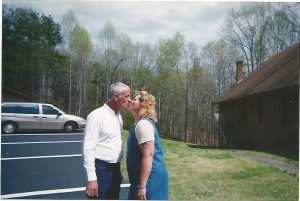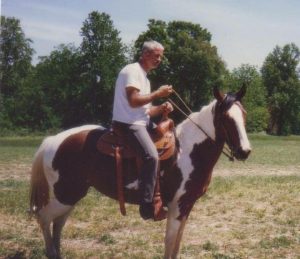Richard Sutphin suffered with Crohn’s Disease for years before a multidisciplinary team at UNC helped him get his life back.

Richard Sutphin suffered with Crohn’s Disease for years before a multidisciplinary team at UNC helped him get his life back.


At 57 years old Richard Sutphin is getting an opportunity to live again. Plagued with digestion issues his entire life, he was finally diagnosed at the age of 40 with Crohn’s disease. A construction worker by trade, Richard had found his way down to Louisiana after the catastrophic impact of hurricane Katrina. He was helping the city of New Orleans rebuild, working with a crew to bring the city back to life. While in Louisiana, Sutphin’s disease worsened, so much so that he was forced to leave his job and travel back to his home in Cleveland, North Carolina to seek treatment from local doctors.
Crohn’s disease is an inflammatory bowel disease that affects the lining of the digestive tract. While an exact cause remains unknown, a malfunctioning immune system or hereditary factors may play a role. Crohn’s causes inflammation of the entire bowel wall, both on the surface and inside that result in strictures, abscesses, or fistulas (holes in the abdomen). The inflammation can involve the intestine from the mouth to the anus, can exist in more than one location in the intestine, and is very common in the colon and the stomach. About 780,000 people in the US suffer from Crohn’s disease with 6-15 new cases diagnosed per 100,000 people each year.
In 2012, six months after returning from Louisiana, Sutphin underwent surgery to treat complications of his Crohn’s disease. Over time the surgery proved ineffective, and his condition continued to deteriorate. “It wasn’t long after (surgery) that I developed holes in my belly,” Sutphin said.
The holes were punctures of his intestine leading out of his abdomen, allowing whatever he ate to exit his body through those holes. “I was going to a hospital near me, and they were trying to help but nothing they did fixed the problem,” Sutphin said. “I went through that for ten years. I had to have a large bag over my stomach because everything I was eating was seeping out of me uncontrollably.”
Over a period of 10 years, Sutphin went from a vibrant 6 foot, 180-pound man to a shell of his former self. Over time, he started to lose hope as he found himself down to his lowest weight of 84 pounds. He was able to eat or drink very little due to increasing pain in his stomach. Without food and nutrients, he became emaciated, unable to walk or function normally.
“Before I was diagnosed, I worked 10 to 12 hours doing construction and remodel work,” says Richard. “I had outside hobbies like working on antique cars with my sons. My wife and I used to enjoy riding our horses; we had eight at one point. We haven’t done much of anything in the last ten years,” Sutphin said.
In February of 2018, Richard was diagnosed with a blockage in his intestine and was referred to the doctors at UNC Health Care.
“When we first saw him, he was very much skin and bones,” says Dr. Alessandro Fichera, Colon and Rectal Surgeon and Chief of the Division of Gastrointestinal Surgery at UNC. “His condition was quite extreme. It required us to put together a multidisciplinary team to tackle the case.”
Before undergoing surgery, the GI surgeons began by getting a comprehensive roadmap of his disease, which proved difficult to obtain because of his history of fistulas and his unusual intra-abdominal situation. Then they focused on how to optimize his nutrition. They first tried giving him nutrition through an I.V. as an outpatient. Difficulties arose after he received his nutrition, as he would either develop a blockage or experience pain or vomiting associated with dehydration that ultimately necessitated his return to the hospital. After three attempts, the doctors decided to keep him in the hospital for six weeks to optimize his nutrition under supervision.
In a combined effort, the Department of Gastrointestinal Surgery and the Department of Nutrition and Gastrointestinal Medicine at UNC Health Care worked together to help Sutphin improve enough to be a candidate for surgery. Without their efforts, he would not have been able to receive the life-saving operation. They worked in a coordinated effort to create a comprehensive plan that included fluids and nutrition through IVs in his arm in addition to a feeding tube in his stomach so that he could obtain the calories, vitamins, and minerals he needed to gain back his strength
During the surgery, Dr. Fichera and his team identified the area of the intestine that contained the holes, discovering that most of his small bowel was damaged and nonfunctioning. That left them in a difficult position as they worked to repair the results of the disease while also saving enough intestine for Richard to be able to live comfortably. They also had to investigate the cause of the persistent holes. They discovered that there was a complete blockage of the small intestine distal to the holes resulting in the inability for food to pass through, thus causing pressure to build up and consequently leading to the draining out of the fistulas. The surgeons fixed the blockage and removed the area with the holes. They then made sure that everything could flow through, eliminating all the blockages, removing the scar tissue as well as the infection in the abdomen and the abdominal wall.
“Once he (Dr. Fichera) did the surgery, it’s like night and day difference to me,” says Richard. “I’ve gained about 30 pounds back. I feel like I’ve been given a chance to last a little longer. I had gotten to the point of giving up. It feels like a miracle to me. Dr. Fichera was one of the best doctors I’ve ever met. He pretty much tells you like it is, but he really cares. To me, that is something that is pretty rare.”
After the surgery, Richard received intestinal rehabilitation, allowing Richard’s intestines to learn how to function properly again. They continued to give him nutrition and fluids through the IV and feeding tube but slowly removed both over time as his condition continued to improve.
“While the surgery was complicated for sure, it was the journey of getting him to the surgery that made the world of difference,” says Dr. Fichera. “This would not have worked if we didn’t have a comprehensive team that worked together including, a nutritionist, a gastroenterologist and wound ostomy nurses. That is the differentiating factor in our institution. We have all these experienced providers working together for the best possible outcome for the patient.”
“Now I am actually absorbing what I eat, explains Sutphin. “It can change a person’s life very quickly. Sometimes it seems slow, but I have to remind myself of where I’ve come. I was beginning to think there was no turning around. To me, people in Chapel Hill are miracle workers. The first hospital that bends over backward to help. I am feeling hopeful about the future.”